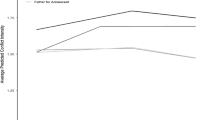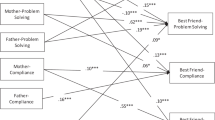Abstract
Adolescent identity and parent–adolescent conflict have each attracted considerable research interest. However, few studies have examined the important link between the two constructs. The present study examined the associations between adolescent identity processing styles and adolescent conflict resolution styles in the mother–adolescent dyad. Questionnaires about conflict frequency and resolution were completed by 796 adolescents (66% female, mostly Caucasian) and their mothers. Adolescents also completed a measure on identity styles. Each identity style was hypothesized to relate to a specific conflict resolution behavior. Hierarchical regression analyses showed that the information-oriented identity style was positively associated with positive problem solving and negatively with conflict engagement and withdrawal, the normative style was positively associated with compliance, and, finally, the diffuse-avoidant style was positively associated with withdrawal and conflict engagement and negatively with positive problem solving. Our results demonstrated that the way in which adolescents tackle identity-relevant issues is related to the way in which they deal with conflicts with their mothers. Implications and suggestions for future research are discussed.
Similar content being viewed by others
References
Adams, R., & Laursen, B. (2001). The organization and dynamics of conflict with parents and friends. Journal of Marriage and Family, 63, 97–110.
Adams, R. E., & Laursen, B. (2007). The correlates of conflict: Disagreement is not necessarily detrimental. Journal of Family Psychology, 21, 445–458.
Adams, G. R., & Marshall, S. K. (1996). A developmental social psychology of identity: Understanding the person-in-context. Journal of Adolescence, 19, 429–442.
Adams, G. R., Munro, B., Doherty-Poirer, M., Munro, G., Petersen, A. R., & Edwards, J. (2001). Diffuse-avoidance, normative, and information-oriented identity styles: Using identity theory to predict maladjustment. Identity: An International Journal of Theory and Research, 1, 307–320.
Archer, S. L., & Waterman, A. S. (1990). Varieties of identity diffusions and foreclosures: An exploration of subcategories of the identity statuses. Journal of Adolescent Research, 5, 96–111.
Barber, B. K., Stolz, H. E., & Olsen, J. A. (2005). Parental support, psychological control, and behavioral control: Assessing relevance across time, method, and culture. Monographs of the Society for research in Child Development, 70(4, Serial No. 282).
Berzonsky, M. D. (1985). Diffusion within Marcia identity-status paradigm: Does it foreshadow academic problems? Journal of Youth and Adolescence, 14, 527–538.
Berzonsky, M. D. (1989). Identity style: Conceptualization and measurement. Journal of Adolescent Research, 4, 268–282.
Berzonsky, M. D. (1990). Self-construction over the life-span: A process perspective on identity formation. In G. J. Neimeyer & R. A. Neimeyer (Eds.), Advances in personal construct psychology (Vol. 1, pp. 155–186). Greenwich, CT: JAI Press.
Berzonsky, M. D. (1992). Identity style and coping strategies. Journal of Personality, 60, 771–788.
Berzonsky, M. D. (2004). Identity style, parental authority, and identity commitment. Journal of Youth and Adolescence, 33, 213–220.
Berzonsky, M. D. (in press). A social-cognitive perspective on identity construction. In S. J. Schwartz, K. Luyckx, & V. L. Vignoles (Eds.), Handbook of identity theory and research. New York: Springer.
Berzonsky, M. D., Branje, S. J. T., & Meeus, W. (2007). Identity processing style, psychosocial resources, and adolescents’ perceptions of parent-adolescent relations. Journal of Early Adolescence, 27, 324–345.
Berzonsky, M. D., & Sullivan, C. (1992). Social-cognitive aspects of identity style: Need for cognition, experiential openness, and introspection. Journal of Adolescent Research, 7, 140–155.
Bosma, H. A., & Kunnen, E. S. (2001). Determinants and mechanisms in ego identity development: A review and synthesis. Developmental Review, 21, 39–66.
Branje, S. J. T., Van Doorn, M. D., Van der Valk, I., & Meeus, W. H. J. (2009). Parent–adolescent conflicts, conflict resolution types, and adolescent adjustment. Journal of Applied Developmental Psychology, 30, 195–204.
Bronfenbrenner, U. (1989). Ecological system theory. In R. Vasta (Ed.), Annals of child development (Vol. 6, pp. 187–249). Greenwich, CT: JAI Press.
Burk, W. J., Denissen, J., Van Doorn, M., Branje, S. J. T., & Laursen, B. (2009). The vicissitudes of conflict measurement: Stability and reliability in the frequency of disagreements. European Psychologist, 14, 153–159.
Collins, W. A., & Laursen, B. (1992). Conflicts and relationships during adolescence. In C. U. Shantz & W. W. Hartup (Eds.), Conflict in child and adolescent development (pp. 216–241). New York: Cambridge University Press.
Collins, W. A., Laursen, B., Mortensen, N., Luebker, C., & Ferreira, M. (1997). Conflict processes and transitions in parent and peer relationships: Implications for autonomy and regulation. Journal of Adolescent Research, 12, 178–198.
De Goede, I. H. A., Branje, S. J. T., & Meeus, W. H. J. (2009). Developmental changes in adolescents’ perceptions of relationships with their parents. Journal of Youth and Adolescence, 38, 75–88.
De Wied, M., Branje, S. J. T., & Meeus, W. H. J. (2007). Empathy and conflict resolution in friendship relationships among adolescents. Aggressive Behavior, 33, 48–55.
Deković, M., Noom, M. J., & Meeus, W. (1997). Expectations regarding development during adolescence: Parental and adolescent perceptions. Journal of Youth and Adolescence, 26, 253–272.
Erikson, E. H. (1968). Identity: Youth and crisis. New York: Norton.
Goossens, L. (2006). The many faces of adolescent autonomy: Parent-adolescent conflict, behavioral decision-making, and emotional distancing. In S. Jackson & L. Goossens (Eds.), Handbook of adolescent development (pp. 135–153). Hove, UK: Psychology Press.
Grotevant, H. D., & Cooper, C. R. (1985). Patterns of interaction in family relationships and the development of identity exploration in adolescence. Child Development, 56, 415–428.
Holmbeck, G. N., Li, S. T., Schurman, J. V., Friedman, D., & Coakley, R. M. (2002). Collecting and managing multisource and multimethod data in studies of pediatric populations. Journal of Pediatric Psychology, 27, 5–18.
Jaccard, J., & Turrisi, R. (2003). Interaction effects in multiple regression (2nd ed.). Thousand Oaks, CA: Sage.
Jöreskog, K. G., & Sörbom, D. (1993). LISREL VIII users’ reference guide. Mooresville, IN: Scientific Software.
Kline, R. B. (2006). Principles and practices of structural equation modeling (2nd ed.). New York: Guilford Press.
Kroger, J. (2003). Identity development during adolescence. In G. R. Adams & M. D. Berzonsky (Eds.), Blackwell handbook of adolescence (pp. 205–226). Malden, MA: Blackwell.
Kunnen, S. (2006). Are conflicts the motor in identity change? Identity: An International Journal of Theory and Research, 6, 169–186.
Kurdek, L. A. (1994). Conflict resolution styles in gay, lesbian, heterosexual nonparent, and heterosexual parent couples. Journal of Marriage and the Family, 56, 705–722.
Laursen, B. (1993). The perceived impact of conflict on adolescent relationships. Merrill-Palmer Quarterly, 39, 535–550.
Laursen, B., & Collins, W. A. (1994). Interpersonal conflict during adolescence. Psychological Bulletin, 115, 197–209.
Laursen, B., Coy, K. C., & Collins, W. A. (1998). Reconsidering changes in parent–child conflict across adolescence: A meta-analysis. Child Development, 69, 817–832.
Laursen, B., Finkelstein, B. D., & Townsend-Betts, N. (2001). A developmental meta-analysis of peer-conflict resolution. Developmental Review, 21, 423–449.
Lichtwarck-Aschoff, A., van Geert, P., Bosma, H., & Kunnen, S. (2008). Time and identity: A framework for research and theory formation. Developmental Review, 28, 370–400.
Luyckx, K., Goossens, L., Beyers, W., & Vansteenkiste, M. (2005). Identity statuses based upon four rather than two identity dimensions: Extending and refining Marcia’s paradigm. Journal of Youth and Adolescence, 34, 605–618.
Luyckx, K., Lens, W., Smits, I., & Goossens, L. (2010). Time perspective and identity formation: Short-term longitudinal dynamics in college students. International Journal of Behavioral Development, 34, 238–247.
Luyckx, K., Schwartz, S. J., Berzonsky, M. D., Soenens, B., Vansteenkiste, M., Smits, I., et al. (2008). Capturing ruminative exploration: Extending the four- dimensional model of identity formation in late adolescence. Journal of Research in Personality, 42, 58–82.
Marcia, J. E. (1966). Development and validation of ego-identity status. Journal of Personality and Social Psychology, 3, 551–558.
Marcia, J. E. (1989). Identity diffusion differentiated. In M. A. Luszcz & T. Nettelbeck (Eds.), Psychological development: Perspectives across the life-span (pp. 123–137). Dordrecht, The Netherlands: Elsevier.
McGue, M., Elkins, I., Walden, B., & Iacono, W. G. (2005). Perceptions of the parent–adolescent relationship: A longitudinal investigation. Developmental Psychology, 41, 971–984.
Montemayor, R., & Hanson, E. (1985). A naturalistic view of conflict between adolescents and their parents and siblings. Journal of Early Adolescence, 5, 23–30.
Nurmi, J., Berzonsky, M. D., Tammi, K., & Kinney, A. (1997). Identity processing orientation, cognitive and behavioral strategies, and well-being. International Journal of Behavioral Development, 27, 555–570.
Rubenstein, J. L., & Feldman, S. S. (1993). Conflict-resolution behavior in adolescent boys: Antecedents and adaptational correlates. Journal of Research on Adolescence, 3, 41–66.
Satorra, A., & Bentler, P. M. (1994). Corrections to test statistics and standard errors in covariance structure analysis. In A. Von Eye & C. C. Clogg (Eds.), Latent variables analysis: Applications for developmental research (pp. 399–419). Thousand Oaks, CA: Sage.
Schwarz, J. C., Barton-Henry, M. L., & Pruzinsky, T. (1985). Assessing child rearing behaviors: A comparison of ratings made by mother, father, child and sibling on the CRPBI. Child Development, 56, 462–479.
Shantz, C. U. (1987). Conflict between children. Child Development, 58, 283–305.
Smetana, J. G. (1989). Adolescents’ and parents’ reasoning about actual family conflict. Child Development, 60, 1052–1067.
Smetana, J. G., Daddis, C., & Chuang, S. S. (2003). “Clean your room!” A longitudinal investigation of adolescent-parent conflict and conflict resolution in middle-class African American families. Journal of Adolescent Research, 18, 631–650.
Smetana, J. G., Yau, J., & Hanson, S. (1991). Conflict resolution in families with adolescents. Journal of Research on Adolescence, 1, 189–206.
Smits, I., Doumen, S., Luyckx, K., Duriez, B., & Goossens, L. (in press). Identity styles and interpersonal behavior in emerging adulthood: The intervening role of empathy. Social Development.
Smits, I., Soenens, B., Berzonsky, M. D., Luyckx, K., Goossens, L., Kunnen, S., et al. (2009). The identity style inventory—Version 4: A cross-national study in scale development and validation. In L. Goossens (Chair), Capturing identity styles: A cross-national and multi-method view on measurement. Symposium conducted at the 16th annual conference of the Society for Research on Identity Formation (SRIF), Pacific Grove, CA
Smits, I., Soenens, B., Luyckx, K., Duriez, B., Berzonsky, M. D., & Goossens, L. (2008). Perceived parenting dimensions and identity styles: Exploring the socialization of adolescents’ processing of identity-relevant information. Journal of Adolescence, 31, 151–164.
Smits, I., Soenens, B., Vansteenkiste, M., Luyckx, K., & Goossens, L. (2010). Why do adolescents gather information or stick to parental norms? Examining autonomous and controlled motives behind adolescents’ identity style. Journal of Youth and Adolescence, 39, 1343–1356.
Soenens, B., Duriez, B., & Goossens, L. (2005). Social-psychological profiles of identity styles: Attitudinal and social-cognitive correlates in late adolescence. Journal of Adolescence, 28, 107–125.
Steinberg, L. (1990). Interdependency in the family: Autonomy, conflict, and harmony in the parent-adolescent relationship. In S. Feldman & G. Elliot (Eds.), At the threshold: The developing adolescent (pp. 255–276). Cambridge, MA: Harvard University Press.
Tucker, C. J., McHale, S. M., & Crouter, A. C. (2003). Conflict resolution: Links with adolescents’ family relationships and individual well-being. Journal of Family Issues, 24(6), 715–736.
Van Doorn, M. D., Branje, S. J. T., & Meeus, W. H. J. (2007). Longitudinal transmission of conflict resolution styles from marital relationships to parent–adolescent relationships. Journal of Family Psychology, 21, 426–434.
Van Doorn, M. D., Branje, S. J. T., & Meeus, W. H. J. (2008). Conflict resolution in parent- adolescent relationships and adolescent delinquency. Journal of Early Adolescence, 28, 503–527.
Van Doorn, M. D., Branje, S. J. T., & Meeus, W. H. J. (in press). Developmental changes in conflict resolution styles in parent-adolescent relationships: A four-wave longitudinal study. Journal of Youth and Adolescence.
Youniss, J., & Smollar, J. (1985). Adolescent relations with mothers, fathers and friends. Chicago: University of Chicago Press.
Author information
Authors and Affiliations
Corresponding author
Rights and permissions
About this article
Cite this article
Missotten, L.C., Luyckx, K., Branje, S. et al. Identity Styles and Conflict Resolution Styles: Associations in Mother–Adolescent Dyads. J Youth Adolescence 40, 972–982 (2011). https://doi.org/10.1007/s10964-010-9607-5
Received:
Accepted:
Published:
Issue Date:
DOI: https://doi.org/10.1007/s10964-010-9607-5




